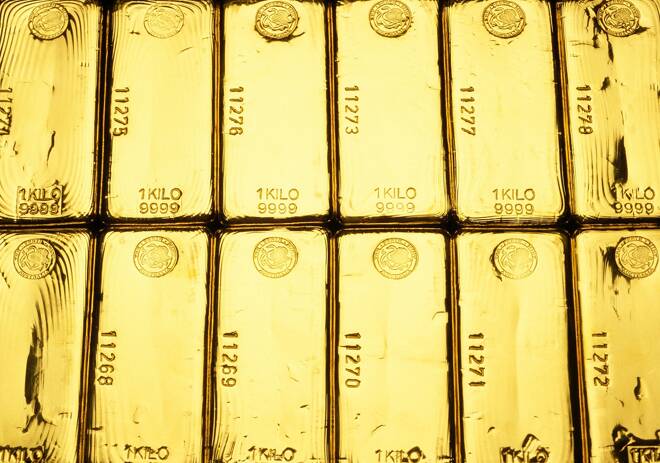Advertisement
Advertisement
The Future Trajectory of Gold Prices (2024-2026): Navigating Economic and Geopolitical Crossroads
By:
Our outlook for gold prices in 2024 – 2026 is based on the possible outcomes of economic policies, geopolitical tensions, and currency dynamics. I
In this analysis, we delve into critical factors that will exert a profound influence on gold’s price structure over the next three years.
Federal Reserve’s Policy Shift: A Balancing Act
One of the more paramount influencers of gold prices is the Federal Reserve’s monetary policy. The shift from quantitative tightening to quantitative easing, coupled with a series of anticipated rate cuts, sets the stage for a dynamic rally in gold.
In 2024, the Federal Reserve is expected to implement rate cuts ranging from three-quarters of a percent to 1%, ultimately bringing the Fed funds rate to 4.6%. The impact of these cuts on gold prices is twofold. On one hand, lower interest rates make non-interest-bearing assets like gold more attractive. On the other, it could signal concerns about economic health, prompting investors to seek the safety of precious metals.
Moving into 2025, the projected interest rates of 3 ½% to 4% continue to stimulate gold’s appeal. As rates drop further to 2 ½% to 3% in 2026, the precious metal may emerge as a favored hedge against inflation and economic uncertainties. Investors are likely to closely monitor these rate adjustments, anticipating their cascading effects on gold prices.
Geopolitical Tensions: A Volatile Backdrop
Geopolitical tensions, a perennial influencer of gold prices, are currently at the forefront of global concerns. The ongoing conflict between Russia and Ukraine, now in its second year, adds a layer of uncertainty to the market. The Hamas invasion of Israel and Israel’s response in October, further contributed to the already volatile global fabric.
What has the potential to escalate the regional conflict is the proxy attacks by Iran on US warships in the region, occurring consistently since the Israeli-Hamas conflict began. Historically, gold has thrived in times of geopolitical uncertainty, with investors seeking refuge in its stability. As these tensions persist, gold prices could experience upward pressure.
Dollar Decentralization: A Paradigm Shift
A seismic shift in global trade dynamics is underway, with alternatives to the US dollar gaining momentum. The recent agreement between Iran and Russia to abandon the US dollar in favor of local currencies for trade is a significant milestone. This move, combined with the utilization of non-SWIFT inter-banking systems, poses a challenge to the traditional dominance of the US dollar.
The formation of the BRICS coalition by countries including Brazil, Russia, India, China, and South Africa could ignite a collective shift away from the dollar in trade transactions. The potential destabilization of the US dollar could have profound implications for gold prices. As faith in the dollar wanes, gold, often viewed as a reliable store of value, may experience increased demand, potentially driving prices higher.
Speculating on Gold Prices: A Complex Equation
Amidst these multifaceted influences, the current trading price of gold at $2080 an ounce sparks speculation about its future trajectory. While predictions are inherently uncertain, considering the aforementioned factors allows for a nuanced analysis.
2024: A Gradual Ascent
Given the anticipated Fed rate cuts and persistent geopolitical tensions, a gradual increase in gold prices seems plausible. A range between $2100 and $2300 per ounce by the end of 2024 is conceivable, reflecting both economic uncertainties and the attractiveness of gold as an investment.
2025: Climbing Higher
Continued rate cuts and geopolitical unrest may propel gold prices even higher in 2025. Speculatively, prices could range from $2400 to $2600 per ounce, with investors increasingly turning to gold as a safe haven amid global uncertainties.
2026: New Peaks?
By 2026, if the Federal Reserve’s monetary policy results in what they currently anticipate, interest rates will be back to normalized levels by now (2% – 3%) and inflation will have been cut down to 2% or lower. This will change the primary drivers for gold price from an inflationary hedge to a haven asset. A potential range of $2600 to $2800 per ounce is within the realm of possibility, as gold solidifies its position as a reliable asset in turbulent times.
As we navigate the intricate web of economic policies, geopolitical tensions, and currency dynamics, predicting the exact trajectory of gold prices remains challenging. While the outlined scenarios provide a framework for analysis, the future of gold prices will be shaped by the evolving interplay of these unpredictable and critical factors. In these uncertain times, a diversified and informed approach to investment is paramount, allowing the investor to adapt and be prepared for the ever-changing currents of the global market.
For those who would like more information simply use this link.
Wishing you as always good trading and a blessed New Year,,
Gary S. Wagner
About the Author
Gary S.Wagnercontributor
Gary S. Wagner has been a technical market analyst for 35 years. A frequent contributor to STOCKS & COMMODITIES Magazine, he has also written for Futures Magazine as well as Barron’s. He is the executive producer of "The Gold Forecast," a daily video newsletter. He writes a daily column “Hawaii 6.0” for Kitco News
Advertisement
